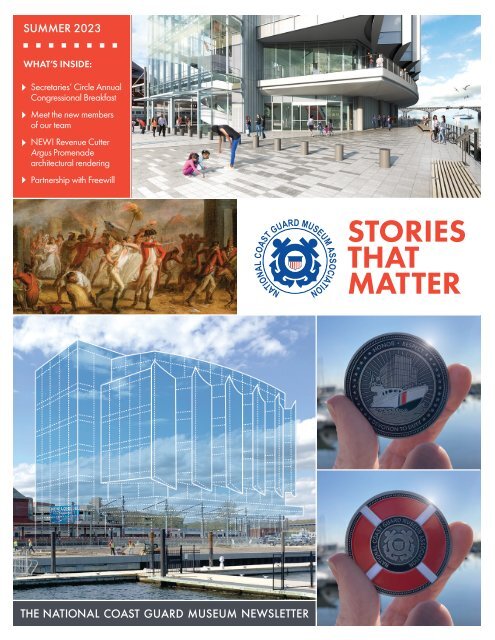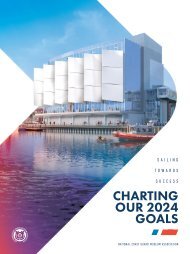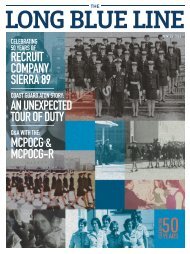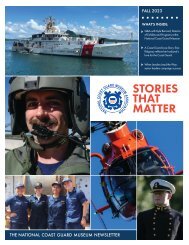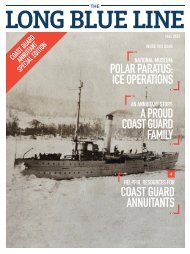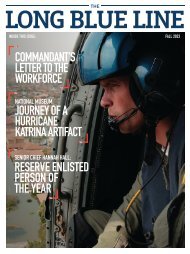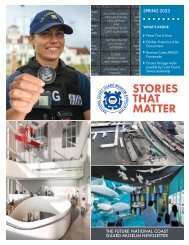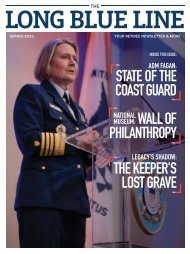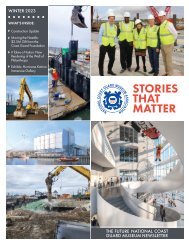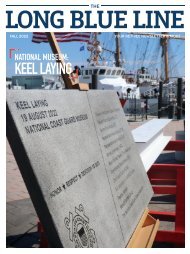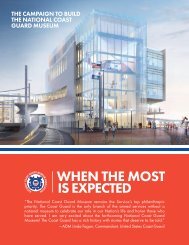NCGMA Newsletter 2023 (Summer)
Catch up on all the recent updates and construction progress for the National Coast Guard Museum.
Catch up on all the recent updates and construction progress for the National Coast Guard Museum.
You also want an ePaper? Increase the reach of your titles
YUMPU automatically turns print PDFs into web optimized ePapers that Google loves.
SUMMER <strong>2023</strong><br />
WHAT’S INSIDE:<br />
Secretaries’ Circle Annual<br />
Congressional Breakfast<br />
Meet the new members<br />
of our team<br />
NEW! Revenue Cutter<br />
Argus Promenade<br />
architectural rendering<br />
Partnership with Freewill<br />
STORIES<br />
THAT<br />
MATTER<br />
SUMMER <strong>2023</strong><br />
PAGE 1
FROM THE PRESIDENT:<br />
BUILDING A MUSEUM FOR ALL<br />
As we come together this month to honor the 233rd birthday of the United States<br />
Coast Guard, I want to take a moment to reflect on the tremendous privilege it is<br />
being involved with building the National Coast Guard Museum. For many of us, the<br />
dream of a national museum to honor our Service was just that—a dream. But now,<br />
as we get closer to meeting our fundraising goals and as phase two of construction<br />
is poised to begin, I can assure you—our dream is becoming a reality.<br />
Creating a museum is complex—from building design and construction, developing<br />
exhibits and programming, to ensuring an engaging visitor experience, and<br />
providing access and sustainability for the community—no stone can be left<br />
unturned. Beyond creating a physical structure to house Coast Guard artifacts,<br />
building the National Coast Guard Museum is a promise to honor all who have<br />
taken the oath to serve—sharing the stories of the entire Coast Guard family: all ranks<br />
and work forces—and ensuring that we create a welcoming space for everyone, in<br />
or out of the Coast Guard family, to engage, learn and appreciate our great Service.<br />
That is what this Museum will achieve, and I’m thrilled with our progress to date.<br />
A tremendous amount of effort and detail has been focused on the preparation of<br />
the museum site. After completing phase one of construction, we are now focused<br />
on phase two, installing micro-piles which will anchor the building to bedrock. We<br />
expect to see steel coming out of the ground in early 2024!<br />
But our work is not confined to the four walls of the museum. We are also committed<br />
to a revitalized waterfront for the entire community. Plans are underway to install<br />
the Revenue Cutter Argus Promenade, which will connect the museum to New<br />
London’s City Pier. Just as the museum will be a welcoming space for everyone,<br />
the promenade will be a wonderful way for anyone to become part of the Coast<br />
Guard legacy while simultaneously supporting our building efforts. Individual<br />
pavers may be purchased to reflect your service, commitment to the museum,<br />
or to honor a loved one. (For more information on our Commemorative Paver<br />
Program, see page 6).<br />
As we head into the second half of <strong>2023</strong>, I am excited about what lies ahead,<br />
proud of our progress, and honored to serve you with this mission. Thank you for<br />
your ongoing support.<br />
CAPT Wes Pulver, USCG (Ret.)<br />
President<br />
National Coast Guard Museum Association<br />
United States Coast Guard Commandant<br />
Admiral Linda L. Fagan joined<br />
dignitaries, members of the Connecticut<br />
delegation, Museum supporters, and the<br />
National Coast Guard Museum Association at<br />
the annual Secretaries’ Circle Congressional<br />
Breakfast. The June event was a celebration<br />
of the successful congressional partnership<br />
responsible for the National Coast Guard<br />
Museum construction and development.<br />
More than 100 attendees gathered in the<br />
historic Kennedy Caucus Room, located in<br />
the Russell Senate Office Building on Capitol<br />
Hill, to be briefed on the Museum project’s<br />
progress. Artifacts from United States Coast<br />
Guard adorned the stately space and will be<br />
on permanent display in the future National<br />
Coast Guard Museum.<br />
PAGE 2<br />
NATIONAL COAST GUARD MUSEUM ASSOCIATION
SECRETARIES’<br />
CIRCLE ANNUAL<br />
CONGRESSIONAL<br />
BREAKFAST<br />
Retired USCG Admiral James M. Loy, former<br />
Deputy Secretary of Homeland Security and<br />
21st Commandant of the United States Coast<br />
Guard, hosted the event. He expressed his<br />
appreciation to members of Congress and<br />
the gathering of Museum supporters. Admiral<br />
Fagan also gratefully acknowledged the<br />
support from Congress and emphasized the<br />
growing enthusiasm surrounding the museum<br />
project. Admiral Fagan said, “It’s happening!”<br />
And with those few simple words, Fagan<br />
captured the palpable excitement that<br />
many supporters of the museum have long<br />
anticipated.<br />
Senator Chris Murphy (D-CT), Chairman of<br />
the U.S. Senate Appropriations Subcommittee<br />
on Homeland Security and a sponsor the<br />
2022 Omnibus Appropriations bill which<br />
secured federal funding for the museum,<br />
was one of the event’s featured speakers. He<br />
expressed the importance in preserving the<br />
enduring maritime history of the Coast Guard<br />
and the value in making their often-groundbreaking<br />
stories accessible to the public.<br />
Senator Murphy was joined by Senator<br />
Richard Blumenthal (D-CT), Representative<br />
Rosa DeLauro (CT-03), and Representative<br />
Joe Courtney (CT-02)—all key supporters of<br />
the project.<br />
Retired USCG Captain Wes Pulver, President<br />
of the National Coast Guard Museum<br />
Association, lauded members of Congress for<br />
their extraordinary efforts to date. He added, “I<br />
want to thank you, especially the Connecticut<br />
delegation, for your critical support that—<br />
combined with city, state, and the generosity<br />
of more than 6,000 individuals and members<br />
of industry—is making the dream of a National<br />
Coast Guard Museum a reality.”<br />
Pulver proudly announced that the first phase of<br />
museum construction (known as bulkhead and<br />
fill) has been completed. Looking forward, he<br />
explained that the second phase of construction<br />
is out for bid. Phase 2 installation of micropiles,<br />
which are a series of load-bearing columns<br />
anchoring the museum to bedrock, will be<br />
awarded this summer, with the goal to have steel<br />
rising from the ground in 2024.<br />
The Museum Association would like to thank all<br />
of those who were able to attend the breakfast<br />
and looks forward to having you join us next<br />
year, as we get ever closer to ribbon cutting.<br />
Upper Left: Admiral Linda Fagan, 27th commandant of the United States<br />
Coast Guard, talks to attendees at the event before briefing the room on the<br />
Coast Guard’s continued commitment to the Nation Coast Guard Museum<br />
as its number one philanthropic priority.<br />
Bottom Left: Architect of the Capitol—the Russell Senate Office Building<br />
(built 1903-1908) is the oldest of the Senate office buildings as well as a<br />
significant example of the Beaux Arts style of architecture.<br />
Right: Dignitaries gather and socialize before enjoying breakfast in the<br />
Kennedy Caucus Room of the Russell Senate Office Building on Capitol Hall.<br />
SUMMER <strong>2023</strong><br />
PAGE 3
MEET THE<br />
NEWEST<br />
MEMBERS<br />
OF OUR<br />
TEAM<br />
Our small, dedicated team,<br />
along with the tremendous<br />
support and initiative of<br />
our Board of Directors and<br />
Capital Campaign Committee<br />
volunteers, are laser-focused<br />
on bringing the National<br />
Coast Guard Museum to<br />
the historic New London,<br />
Connecticut, waterfront. As<br />
construction is progressing<br />
and a museum opening is on<br />
the horizon, we are thrilled to<br />
introduce our newest members<br />
of the Museum Association<br />
team.<br />
PATTI<br />
FAZIO<br />
DIRECTOR OF MARKETING<br />
AND COMMUNICATIONS<br />
With more than 20 years’ experience in strategic marketing<br />
communications, Patti Fazio joins us as the new Director of<br />
Marketing and Communications. She most recently served as<br />
the inaugural Chief Marketing Officer at Wesleyan University<br />
and has also held various communications and brand leadership<br />
positions at the University of Connecticut and UConn Health.<br />
From partnering with Nike to leading teams of 40 marketing<br />
professionals, the depth and breadth of Patti’s experience will<br />
serve the Museum Association well in the coming years. “I am<br />
absolutely thrilled to be part of history-in-the-making,” adds<br />
Patti. Patti and her husband Mike are long-time residents of<br />
Connecticut, and self-proclaimed museum lovers.<br />
pfazio@coastguardmuseum.org<br />
PAGE 4<br />
NATIONAL COAST GUARD MUSEUM ASSOCIATION
LIBBY<br />
DALY<br />
MANAGER<br />
OF MEMBERSHIP<br />
KERRIE<br />
GUARINO<br />
MANAGER<br />
OF ANNUAL GIVING<br />
Libby Daly is a graduate of Clark University in Worcester,<br />
Massachusetts, and holds a bachelor’s degree in government. After<br />
volunteering with several local organizations in her hometown of<br />
Manchester, Connecticut, she decided she wanted to make a career<br />
in non-profits. In 2014, she joined Mystic Seaport Museum as the<br />
Visitor Services Supervisor and Volunteer Coordinator, gradually<br />
transitioning to the Reservations team and then the Membership<br />
Department. In 2017, she was promoted to Associate Director of<br />
Membership where she coordinated operations and developed<br />
member programs. She joins the Museum Association team as<br />
Manager of Membership. “I’m eager to apply all that I’ve learned<br />
to help build a vibrant membership community that will support the<br />
National Coast Guard Museum.” She adds, “There is so much history<br />
here to share with the world and I’m very excited to be a part of the<br />
team that will help make this a reality.” Libby lives in Colchester with<br />
her husband.<br />
ldaly@coastguardmuseum.org<br />
Kerrie Guarino is a graduate of the University of New Hampshire<br />
and obtained her law degree from the Franklin Pierce Law Center at<br />
UNH. After working in the legal field for 14 years, she transitioned<br />
into consulting and technology, working with small to mid-sized<br />
businesses to implement and upgrade enterprise resource and<br />
planning software (ERP), as well as partner with those businesses<br />
to more efficiently use the ERP system to manage their business. In<br />
2018, she took her technology, process improvement, and customer<br />
service expertise to the nonprofit sector. First as a Development<br />
Coordinator at High Hopes Therapeutic Riding, then progressing<br />
to the Development Manager role early in 2022. She joins the<br />
Museum Association Team as the Manager of Annual Giving and<br />
is looking forward to “helping to build a museum that will honor the<br />
Coast Guard’s incredible contributions to the safety and welfare of<br />
our country.” Kerrie resides in Clinton, CT with her husband Rob,<br />
and their two children.<br />
kguarino@coastguardmuseum.org<br />
SUMMER <strong>2023</strong><br />
PAGE 5
BUILDING A MUSEUM<br />
INSIDE & OUT<br />
When you think about a museum, you<br />
think about the exhibits, the stories,<br />
and the immersive experience you<br />
will have as a visitor. As we build the National<br />
Coast Guard Museum, we will continue to<br />
share the historical and engaging content<br />
that will fi ll our galleries and exhibits— but<br />
a museum is so much more. A free national<br />
museum is a destination, part of the city’s<br />
skyline and, in our case, a cornerstone of<br />
the historic Thames River waterfront in New<br />
London, Connecticut. Extending beyond<br />
the walls of the 80,000-square-foot glassenclosed<br />
building, will be a welcoming<br />
waterfront promenade named after the<br />
Revenue Cutter Argus. And we are thrilled<br />
to share with you a rendering of this stunning<br />
outdoor space and invite you to participate<br />
in its creation.<br />
Nestled between City Pier and the ferry<br />
terminals, the Argus Promenade will provide<br />
waterfront access for the entire community<br />
and serve as a meaningful and impactful<br />
welcoming pathway to the National Coast<br />
Guard Museum. Running parallel to the<br />
Thames River, the paved promenade is<br />
named after one of the original 10 cutters<br />
commissioned by the Revenue Marine Service<br />
at the behest of the first Secretary of Treasury<br />
of the United States, Alexander Hamilton<br />
(learn more about the origins of the Revenue-<br />
Marine and the cutter Argus on page 8). This<br />
scenic riverfront location, with its picturesque<br />
views into the active Long Island Sound, its<br />
vibrant sunrises, and gentle lapping waves<br />
will provide a serene backdrop for relaxation<br />
and contemplation about our Nation’s storied<br />
seafaring history.<br />
Built for the community, by the community,<br />
the Argus Promenade is the Museum’s living<br />
archive—a place where you can honor a<br />
patriot, thank a loved one, or carve your<br />
own space in support of the National Coast<br />
Guard Museum through the recently launched<br />
commemorative paver program.<br />
Custom pavers will not only support the mission<br />
of the Museum, but also allow you to be a part<br />
of history in the making. The gray, 3-inch-thick,<br />
textured granite pavers are custom-engraved<br />
and will last for generations. Pavers are<br />
available in two sizes: 4”x 8” and 8”x 8” (and<br />
are 100% tax-deductible). The funds raised go<br />
directly toward the museum’s construction and<br />
supports its mission to educate, honor, and<br />
preserve our rich maritime history through the<br />
lens of the United States Coast Guard.<br />
PAGE 6<br />
NATIONAL COAST GUARD MUSEUM ASSOCIATION
THREE WAYS TO SECURE YOUR PAVER:<br />
1) Order online at www.CGMuseumpavers.com<br />
2) Complete the order form (included) and mail it along with your check to:<br />
National Coast Guard Museum Commemorative Paver Campaign<br />
Fulfillment Center<br />
2700 E. Lanark St., Suite 120<br />
Boise, ID 83642<br />
3) Order by phone using a credit card:1-833-202-0519<br />
SUMMER <strong>2023</strong><br />
PAGE 7
IN A<br />
CUTTER’S<br />
WAKE<br />
After the Revolutionary War, the United<br />
States was burdened with exorbitant<br />
post-war debt. President Washington<br />
and his administration were diligently working<br />
in uncharted political waters to establish a new<br />
government while trying to remain solvent as<br />
a nation. At this time, Alexander Hamilton, the<br />
first Secretary of the Treasury, recognized a<br />
critical need for robust maritime enforcement to<br />
safeguard the Nation’s economic interests and<br />
to combat smuggling and piracy. He presented<br />
his plan of an armed maritime customs<br />
enforcement and tariff collections service to<br />
the newly formed Congress. On August 4,<br />
1790, Congress passed an act establishing the<br />
Revenue-Marine, which laid the groundwork for<br />
the military service recognized around the globe<br />
today as the United States Coast Guard.<br />
Through this Congressional act, the construction<br />
of 10 seagoing Revenue-Marine cutters was<br />
authorized. These cutters were designated to<br />
patrol the coastline, bays, rivers, and littoral<br />
waters of the new republic—each serving a<br />
specified region. To meet the government’s need<br />
for these new cutters, customs collectors in 10<br />
regions identified shipbuilders.<br />
Concurrently, New London, Connecticut, known<br />
for its strategic location along the Thames River,<br />
was undergoing a transformative rebuilding<br />
as it emerged from devastation caused by the<br />
Revolutionary War. Many buildings were razed<br />
or heavily damaged by British raids led by the<br />
infamous Benedict Arnold. However, the resilient<br />
community made quick work reconstructing the<br />
town and restoring its prominence as a maritime<br />
hub.<br />
Post-war activity included the resumption of<br />
maritime commerce, renewing economic activity<br />
in the restored harbor. Ships laden with goods<br />
from around the world once again filled the<br />
port, and the waterfront bustled with merchants,<br />
sailors, and shipbuilders. New businesses and<br />
industries emerged as trade flourished. With<br />
its deep harbor and proximity to major trade<br />
routes, New London regained its status as a<br />
thriving port city. Its shipyards, renowned for<br />
their quality and craftsmanship, played a pivotal<br />
PAGE 8<br />
NATIONAL COAST GUARD MUSEUM ASSOCIATION
Upper Left: There are no known images of the Revenue Cutter<br />
Argus. This image is a sloop in New York Harbor circa 1880. The<br />
Argus was most likely built in a similar fashion. (Hudson River<br />
Maritime Museum archive)<br />
Bottom Left: Burning of New London; oil on canvas painted by<br />
John Trumbull. John Trumbull (June 6, 1756 – November 10,<br />
1843) was an American artist of the early independence period,<br />
notable for his historical paintings of the American Revolutionary<br />
War.<br />
Right: Engraving of Continental Army General Jedediah Huntington<br />
by H. B. Hall.<br />
role in the town’s rebuilding efforts, constructing<br />
vessels to meet the demands of a resurgent<br />
maritime industry—including one of the ships<br />
for the newly formed Revenue-Marine.<br />
At this time, Continental Army General Jedediah<br />
Huntington, a Revolutionary War veteran and<br />
graduate of Harvard University, was serving as<br />
the newly appointed customs collector for New<br />
London—one of the designated cutter seaports.<br />
Huntington was instrumental in overseeing the<br />
construction and outfitting of Connecticut’s<br />
assigned cutter, which would be named<br />
Argus. The vessel was a sloop, a one-masted<br />
sailboat with a fore-and-aft mainsail and a<br />
jib. He contracted a local shipbuilding family<br />
and worked closely with the commissioned<br />
ship captain, Jonathan Maltbie, a Continental<br />
Navy veteran and respected mariner. Once<br />
the vessel’s construction was completed in New<br />
London, the cutter was moved several miles<br />
down the shoreline to the town known today<br />
as Niantic, where it was rigged and outfitted at<br />
Beckwith’s boatyard in Keeney Cove. The vessel<br />
began patrolling Connecticut and Rhode Island<br />
waters in October 1791.<br />
When not at sail, the Argus split its time<br />
between its mooring in New London’s harbor<br />
and a station in New Haven. Living up to the<br />
region’s shipbuilding reputation, Argus proved<br />
to be crafted of the highest quality methods and<br />
materials. The longest-lasting of the original 10<br />
cutters, the Argus served an outstanding 13<br />
years of service—a testament to its superior<br />
construction.<br />
During its life in service, the Argus played a<br />
crucial role in enforcing Alexander Hamilton’s<br />
vision of maritime law. Although few substantial<br />
records survive concerning any of the first 10<br />
cutters’ activities, various accounts indicate that<br />
these vessels most likely served a wide variety<br />
of needs, including boarding incoming and<br />
outgoing vessels, ensuring that all cargoes were<br />
properly documented, sealing cargo holds of<br />
incoming vessels, and seizing vessels that were<br />
in violation of the law. The Revenue-Marine also<br />
took on the responsibility of aiding and assisting<br />
troubled vessels and, in 1832, revenue cutters<br />
were ordered to conduct winter cruises to assist<br />
mariners in need. In 1837, Congress codified<br />
this practice as an official part of its regulations.<br />
The Revenue Cutter Argus Promenade at the<br />
National Coast Guard Museum will serve as<br />
a gateway for museum patrons, residents, and<br />
visitors to the city to explore more than two<br />
centuries of maritime and Coast Guard history.<br />
Every view from the Promenade brings to life<br />
the history of this important harbor and illustrates<br />
its maritime relevance today. Looking a short<br />
distance south from the Promenade is where the<br />
Argus was once likely stationed. In the same<br />
vicinity along City Pier, the USCGC Barque<br />
Eagle, the Nation’s only remaining active military<br />
sailing training vessel will soon be homeported.<br />
Further along the Thames River waterfront, a<br />
stunning reproduction of the historic early 19th<br />
century top-sail schooner La Amistad is docked.<br />
Facing inland from the Promenade, buildings<br />
predating the Revolutionary War stand as<br />
beacons of the town’s historical significance, its<br />
cultural heritage, and architectural importance.<br />
Across the river, it is easy to see that the<br />
shipbuilding industry remains robust. Today, the<br />
ships being built are no longer wooden sloops<br />
or schooners, but state-of-the-art submarines at<br />
the General Dynamics Electric Boat shipyard.<br />
Indeed, the Argus Promenade is the heart of<br />
maritime history in all directions!<br />
SUMMER <strong>2023</strong><br />
PAGE 9
A FAMILY<br />
AFFAIR<br />
Honoring their late father, retired United<br />
States Coast Guard Captain Graeme<br />
Mann, and the final wishes of their<br />
mother, Barbara Mann, three siblings, Wilson,<br />
Gary, and Emily joined together to make a gift<br />
to the National Coast Guard Museum. In their<br />
own words, here is their story.<br />
Q: What did the Coast Guard mean to<br />
you and your family while you were<br />
growing up?<br />
A: Being in the Coast Guard meant that no<br />
matter where my parents were stationed, they<br />
had an instant “Coastie” family. When my father<br />
graduated from the Coast Guard Academy, his<br />
first assignment was in Honolulu, Hawaii, on<br />
a buoy tender. When they arrived, my mother<br />
instantly had 14 “sisters,” many were also<br />
young newly married Coast Guard wives. They<br />
all had nicknames for each other indicating<br />
instant friendships. My mother’s nickname was<br />
“Mighty Mouse” because of her petite size<br />
and boundless energy. This was so important<br />
for wives and friends to help each other and<br />
mentor each other while the husbands were out<br />
at sea for up to 6 months at a time.<br />
Our father grew up in Allentown, Pennsylvania,<br />
with one older brother, one younger brother,<br />
and two younger sisters. The family didn’t have<br />
much money during the depression. The Coast<br />
Guard gave him the ability to break out of a<br />
meager lifestyle—to provide an opportunity<br />
for a very rewarding career. He was the first<br />
child in his family to have the opportunity to<br />
go to college. He appreciated the opportunity<br />
to complete his grad work at MIT and finished<br />
with a Masters in Naval Architecture and Naval<br />
Engineering. Even though he was an officer,<br />
he was a true mechanic and loved hands-on<br />
work. He published a paper on propulsion drive<br />
shaft improvements, worked on the gas turbine<br />
propulsion for the Hamilton high speed cutter<br />
class, and worked on the propulsion design for<br />
the Polar Star and Polar Sea. But his true home<br />
was down in the engine room. While in port or<br />
at the shipyards, he would get calls after hours<br />
to troubleshoot problems, debate options, and<br />
talk through potential solutions. But when the<br />
ship called exclaiming “Redbugs in the Engine<br />
Room, we need your help!”—well, that meant<br />
there were lobsters on board.<br />
Ultimately being a part of the Coast Guard<br />
meant that there was no stronger unit than<br />
our family. We had no choice but to cling<br />
together and get through whatever we needed<br />
to because we moved so often that we were<br />
the only real constant in each other’s lives. The<br />
three of us are completely different and yet full<br />
of profound love, respect, and compassion for<br />
one another—as we were of our parents, in part<br />
because of our shared Coast Guard experience.<br />
Q: With so many important philanthropic<br />
opportunities, what made you choose<br />
to support the National Coast Guard<br />
Museum?<br />
A: Our father adored being in the Coast Guard.<br />
His career, along with his family, was truly his<br />
pride and joy. And my mother was right there<br />
with him all the time. It would not even occur to<br />
us to do otherwise. We knew nothing about the<br />
museum, but shortly before our mother died, she<br />
showed us a magazine article and expressed<br />
her wish to contribute. She started the ball<br />
rolling, and it was an honor for us to make this<br />
gift as a family.<br />
Q: What is the funniest family memory<br />
you would like to share with our readers<br />
to bring to life your father and mother?<br />
A: We loved visiting my father on his various<br />
ships, and I (Emily) am so sentimental about that<br />
particular wardroom smell to this day. I could<br />
pinpoint it anywhere, and it always brings me<br />
joy because it meant he was home.<br />
Q: What is your hope for the National<br />
Coast Guard Museum?<br />
A: The Nation knows so much about the other<br />
branches of the Armed Forces because of their<br />
involvement in war, and, to a certain extent, not<br />
many of our friends growing up were familiar<br />
with the Coast Guard either. When asked why<br />
he chose the Coast Guard, our father said, “It’s<br />
about saving lives, not taking them.” We hope<br />
this museum shares the great works achieved by<br />
the Coast Guard community and their families.<br />
And as education has always been important to<br />
our family, so too do we hope this museum will<br />
educate people to the important mission of the<br />
United States Coast Guard.<br />
PAGE 10<br />
NATIONAL COAST GUARD MUSEUM ASSOCIATION
<strong>NCGMA</strong><br />
IN SEATTLE<br />
On June 29, retired United States Coast<br />
Guard Captain Wes Pulver, National<br />
Coast Guard Museum Association<br />
President, hosted a reception at the Mercer<br />
Island VFW Post in Seattle, Washington.<br />
Coast Guard retirees, auxiliarists, activeduty<br />
members, reservists, and friends of the<br />
Washington region Coast Guard turned out<br />
to enjoy cold libations and a barbeque-style<br />
meal including chopped pork, pulled chicken,<br />
beans, and coleslaw prepared by Tacoma’s<br />
Famous Dave’s restaurant. With a reunion-like<br />
atmosphere, Coasties kicked off the evening<br />
by sharing sea-stories, reminiscing with former<br />
Service mates, building new friendships, and<br />
even spinning a few yarns.<br />
After the plates were finished, attendees were<br />
updated on the current construction progress<br />
for the National Coast Guard Museum and<br />
laid out the comprehensive projected path<br />
toward construction completion and the<br />
Museum’s opening ceremonies.<br />
Also discussed was the evolution of the Long<br />
Blue Line, the Coast Guard retirees’ quarterly<br />
magazine. As an important avenue of<br />
communication for the Coast Guard, which is<br />
produced by the Museum Association, the Long<br />
Blue Line has become a cherished publication<br />
for the entire Coast Guard community. As the<br />
museum heads closer to opening day, the<br />
Museum Association is exploring options to<br />
keep the magazine intact and explore how its<br />
content could be expanded—keeping readers<br />
informed on upcoming events and programming<br />
at the National Coast Guard Museum, regional<br />
Coast Guard museums, and partnered maritime<br />
museums.<br />
As momentum in the building of the National<br />
Coast Guard Museum continues—with its<br />
many ways to support the project, share<br />
incredible Coast Guard stories, develop<br />
future exhibits, and expand the Long Blue<br />
Line—the National Coast Guard Museum<br />
Association will continue to host events to<br />
get the word out to our community and<br />
solicit ideas, stories, and feedback. We look<br />
forward to sharing a meal and hearing from<br />
you at our next event.<br />
Pulver concluded the evening by adding, “Just<br />
as the Nation is thankful for their service, I am<br />
honored to have the opportunity to be part of<br />
building the National Coast Guard Museum<br />
to preserve the rich history of the United States<br />
Coast Guard and to raise awareness and<br />
appreciation of this indispensable Service<br />
for generations to come.”<br />
<strong>NCGMA</strong> PARTNERSHIP<br />
WITH FREEWILL<br />
August is National Make-A-Will Month,<br />
and creating a will is one of the best<br />
ways to plan for the future, safeguard<br />
your loved ones as well as your assets, and<br />
have a lasting impact on causes important to<br />
you. That’s why the National Coast Guard<br />
Museum Association has joined the FreeWill<br />
community. With its easy-to-use online estate<br />
planning tool, FreeWill allows you to support<br />
the National Coast Guard Museum in a way<br />
that works best for you.<br />
FreeWill makes estate planning friendly, simple,<br />
and intuitive—and it’s totally free. Freewill estate<br />
plans are 100% legal and specifically tailored<br />
to your jurisdiction. During last year’s Make-A-<br />
Will Month, more than 70,000 people trusted<br />
them to create their will at no cost and protect<br />
what they value most. And FreeWill makes<br />
charitable giving especially easy. To date,<br />
more than $7.8 billion has been designated to<br />
nonprofit organizations through FreeWill.<br />
By creating a legally binding document that<br />
outlines your wishes, you can ensure that your<br />
loved ones are taken care of and that your<br />
estate is distributed according to your specific<br />
instructions. A will provides clarity, minimizes<br />
potential conflicts, and prevents the state<br />
from making decisions regarding your estate.<br />
It empowers you to have control over the<br />
disposition of your assets and provides peace<br />
of mind.<br />
Many people who create their estate plans<br />
also choose to leave a gift to a cause they care<br />
about, and we hope you’ll consider doing<br />
the same. It’s never too soon to consider the<br />
legacy you want to leave behind—one that will<br />
have meaningful impact on the creation of the<br />
National Coast Guard Museum. Join thousands<br />
of donors in establishing a will that includes a<br />
charitable donation using FreeWill.<br />
www.freewill.com/ncgma<br />
SUMMER <strong>2023</strong><br />
PAGE 11
Get Your<br />
NATIONAL COAST GUARD MUSEUM<br />
<strong>2023</strong> CHALLENGE COIN<br />
Today!<br />
NEWLY<br />
DESIGNED<br />
CHALLENGE<br />
COIN ADDED TO<br />
THIS LIMITED<br />
COLLECTOR’S<br />
SERIES<br />
The USCG 47-foot Motor Lifeboat takes<br />
center stage as we honor the skills and<br />
tenacity of all the boat forces crews. To<br />
get your coin, become a Plankowner or<br />
upgrade your current Plankowner gift ($5<br />
per month minimum) before September<br />
30, <strong>2023</strong>. For more information on how<br />
to join our Plankowner Crew or upgrade<br />
your current monthly gift, please visit:<br />
www.coastguardmuseum.org/plankowner<br />
JOIN.<br />
UPGRADE.<br />
SUPPORT.<br />
VISIT:<br />
coastguardmuseum.org/plankowner<br />
CALL:<br />
860-443-4200<br />
EMAIL:<br />
donate@coastguardmuseum.org<br />
PAGE 12 info@coastguardmuseum.org www.CoastGuardMuseum.org @USCGMuseum NATIONAL COAST GUARD MUSEUM @USCGMuseum ASSOCIATION


